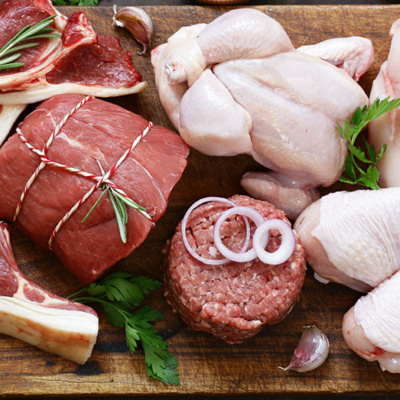top of mind news
- 3 Ways To Celebrate National Pasta Month
- Redesigning Your Drink Menu for Success
- Five Creative Ways to Use Digital Signage in Your Restaurant
- Elevate Your Food Safety Culture to Survive the COVID Crisis and Future Ones
-
Touchless Tech Gets Prioritized At Restaurant Chains During The Coronavirus Pandemic
Poultry
 Weekly chicken production for the week ending October 10th fell 3.6% (y/y), but bird weights remained record heavy leaving ready-to-cook output down a more muted 1.8% (y/y). Chicken production is not looking to recover much over the coming weeks, with broiler type chicks placed being down 3% from a year ago. Chicken prices are mostly mixed as production dwindles. On the white meat complex, both breast meat and tender prices continue to fade but the wing markets are strong. Still, anticipate a softer price undertone for wings later this month as more holiday-oriented protein offerings take center stage. Leg quarter prices continue to head higher, extending the uptrend noted from early September onward. Further upside prices are likely.
Weekly chicken production for the week ending October 10th fell 3.6% (y/y), but bird weights remained record heavy leaving ready-to-cook output down a more muted 1.8% (y/y). Chicken production is not looking to recover much over the coming weeks, with broiler type chicks placed being down 3% from a year ago. Chicken prices are mostly mixed as production dwindles. On the white meat complex, both breast meat and tender prices continue to fade but the wing markets are strong. Still, anticipate a softer price undertone for wings later this month as more holiday-oriented protein offerings take center stage. Leg quarter prices continue to head higher, extending the uptrend noted from early September onward. Further upside prices are likely.
Beef
Beef production jumped week to week, up 2.7%, but last week’s 549.7 million pounds was 4.2% larger than year ago levels. The beef cutouts continued to fade, with Choice averaging $2.110 throughout the week, while losses across the loin primal remained the most prevalent. But price increases held across the rib cuts, and further upside may be noted. Spot beef sales were active last week, with sales of fabricated Choice cuts up 56% (y/y), which were the best for the week since 2009. Seasonally rising beef prices are likely to reemerge into early November, but increases may be more muted than typically is the case.
Pork
Last week’s hog slaughter came in at 2.69 million head, down 1.3% (y/y) but slightly heavier hogs caused last week’s 572.7 million pounds of pork produced to be down just 0.8% (y/y). Tighter pork production schedules continue to support the wholesale markets, with last week’s daily USDA cutout breaking the $1.00 mark for the first time since mid-May. Bellies and hams remained key drivers for those increases, but movement across the hams and picnics were robust also. Still, better output is likely into the late fall which should temper price rises.
THE SEA
Seafood
World snow crab supplies remain limited despite erratic foodservice demand. The U.S. imported 81% more snow crab than the previous year in August but once again it took inflated price levels to do so. The 2020-21 Alaskan snow crab quota has been set at 45 million pounds. This compares to 27.6 million pounds with the prior season. This should temper any further upside in prices.
THE GARDEN
Produce
The tomato markets remain firm due to very limited supplies. Adverse weather has shortened the crop out of the Southeastern states as well as in California. U.S. tomato shipments as of late have been tracking 20% plus below year ago levels. The tight tomato supply is expected to persist in the near term which should underpin prices. Notable tomato supply relief may not occur until next month. Lettuce supplies remain short as well which is inflating the markets. Yet, history suggests that the risk in the lettuce markets is to the downside.
THE KITCHEN SINK
Dairy
CME cheese block and barrel prices remain historically inflated. U.S. cheese production during August was down 2.1% (y/y) and was 1.6% smaller than July. The spot cheese markets could remain firm in the near term but notably lower CME cheese futures in 2021 hint that cheaper block prices should occur this fall. CME spot butter prices strengthened since last week but are still cheap for October. August domestic butter output was up 7.8% (y/y) but down 1.6% (m/m). The downside risk for the spot butter market is likely limited. Spot nonfat dry milk prices usually remain firm during November (from October).
Grains
The USDA is currently projecting 2020-21 corn supplies to be adequate. However, weather concerns with the crops in South America as well as a lackluster finish in the U.S. crop accompanied with strong export demand are underpinning the grain markets. The corn market could remain inflated into the winter.
Oil
Last week nearby WTI crude oil futures were lower (w/w) but have been range bound from $36 to $41 the last few weeks. Lackluster travel activity is keeping a lid on crude oil prices, but tempered production will likely keep prices supported.












